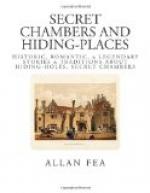[Illustration: ENTRANCE TO SECRET PASSAGE, “ABDICATION HOUSE,” ROCHESTER]
[Illustration: “ABDICATION HOUSE,” ROCHESTER]
James objected strongly to this; the place, he said, was damp and unfurnished (which, by the way, was not the case if we may judge from Evelyn, who visited the mansion not long before, when it was “furnished like a great Prince’s”—indeed, the same furniture remains intact to this day), and a message was sent back that if he must quit Whitehall he would prefer to retire to Rochester, which wish was readily accorded him.
CHAPTER X
JAMES II.’S ESCAPES (continued), HAM HOUSE, AND “ABDICATION HOUSE”
Tradition, regardless of fact, associates the grand old seat of the Lauderdales and Dysarts with King James’s escape from England. A certain secret staircase is still pointed out by which the dethroned monarch is said to have made his exit, and visitors to the Stuart Exhibition a few years ago will remember a sword which, with the King’s hat and cloak, is said to have been left behind when he quitted the mansion. Now there existed, not many miles away, also close to the river Thames, another Ham House, which was closely associated with James II., and it seems, therefore, possible, in fact probable, that the past associations of the one house have attached themselves to the other.
In Ham House, Weybridge, lived for some years the King’s discarded mistress Catherine Sedley, Countess of Dorchester. At the actual time of James’s abdication this lady was in France, but in the earlier part of his reign the King was a frequent visitor here. In Charles II.’s time the house belonged to Jane Bickerton, the mistress and afterwards wife of the sixth Duke of Norfolk. Evelyn dined there soon after this marriage had been solemnised. “The Duke,” he says, “leading me about the house made no scruple of showing me all the hiding-places for the Popish priests and where they said Masse, for he was no bigoted Papist.” At the Duke’s death “the palace” was sold to the Countess of Dorchester, whose descendants pulled it down some fifty years ago. The oak-panelled rooms were richly parquetted with “cedar and cyprus.” One of them until the last retained the name of “the King’s Bedroom.” It had a private communication with a little Roman Catholic chapel in the building. The attics,




